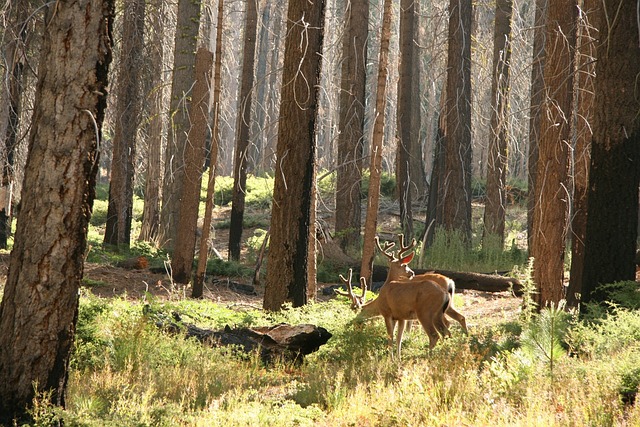Turkey Hunting vs Deer Hunting: A Comprehensive Comparison

Turkey hunting and deer hunting are two popular outdoor sports that attract a significant number of hunters each year. While both activities involve hunting, they differ in many ways. Turkey hunting is typically more challenging and requires a higher level of skill than deer hunting.
One of the primary differences between turkey hunting and deer hunting is the difficulty involved. Turkeys have excellent eyesight and are extremely cautious, making them difficult to hunt.
In contrast, deer are more easily spotted and can be hunted from a distance. Turkey hunting requires a great deal of patience and skill, as hunters must remain still and quiet for extended periods to avoid scaring off their prey.
Another significant difference between turkey hunting and deer hunting is the seasonality of the sport. Deer hunting is typically done in the fall, while turkey hunting is done in the spring.
This means that hunters who enjoy both sports can participate in hunting activities throughout the year. Additionally, turkey hunting is often seen as a more social activity, as hunters frequently hunt in groups and communicate with one another while in the field.
Differences Between Turkey Hunting and Deer Hunting
Terrain
Turkey hunting often takes place in more open fields and meadows, while deer hunting usually involves dense forests and wooded areas.
Turkey hunters typically use ground blinds or lay flat on the ground to stay hidden, while deer hunters often use elevated stands to gain a better view of their surroundings.
Behavior
Deer are generally more cautious and easily spooked than turkeys, which can make them more difficult to hunt. Turkeys are also more vocal, making it easier for hunters to locate them through their calls.
Deer hunters often rely on scent control to remain undetected, while turkey hunters focus more on their calling techniques.
Calls and Decoys
Both turkey and deer hunters use calls to attract their prey, but the types of calls and the techniques used can vary.
Turkey hunters often use a variety of calls, including gobble calls, hen calls, and owl calls, to mimic the sounds of different birds and prey. They also frequently use decoys to attract turkeys to their location.
Deer hunters typically use grunt calls and rattling antlers to mimic the sounds of deer, and may also use decoys to lure them in.
Overall, the differences between turkey hunting and deer hunting come down to the behavior and habitat of the animals, as well as the techniques and equipment used by hunters. Both types of hunting require patience, skill, and a deep understanding of the species being hunted.
Challenges of Turkey Hunting
Knowledge and Experience
Unlike deer hunting, turkey hunting requires a hunter to have a specific set of knowledge and experience. Turkey hunters need to know the turkey’s habitat, behavior, and vocalizations.
They must also understand how to use turkey calls and decoys to lure the birds into range. Without this knowledge and experience, a turkey hunter’s success rate can be low.
It is important to note that the turkey’s behavior and habitat can vary depending on the region. Turkey hunters should consult with their local DNR or turkey biologist to learn about the specific challenges and opportunities in their area.
Patience
Turkey hunting requires a lot of patience. Unlike deer hunting, where hunters can set up a stand and wait for a deer to come by, turkey hunting requires a hunter to actively pursue the birds.
This means traversing through the turkey’s habitat, which can be challenging and tiring. It also means waiting for the right moment to make a shot, which can take hours.
Patience is also required when using turkey calls and decoys. It can take time for a turkey to respond to a call or decoy, and hunters need to be patient and wait for the bird to come into range.
Tactics
Turkey hunting requires a different set of tactics than deer hunting. Hunters need to be able to move quietly through the turkey’s habitat, which can be difficult in noisy conditions. They also need to be skilled with a shotgun, as turkey hunting requires a quick and accurate shot.
Successful turkey hunters use a variety of tactics to lure the birds into range. This can include using different types of calls and decoys, as well as setting up in different locations. It is important for hunters to be adaptable and willing to try new tactics in order to increase their chances of success.
Spring Turkey Hunting
Ambush and Blind Hunting
Spring turkey hunting can be done in several ways, but one of the most popular is ambush and blind hunting. This method involves setting up a blind or hiding in natural cover and waiting for the turkeys to come to you.
It is important to be patient and still, as turkeys have excellent eyesight and can detect movement from far away. Hunters should also be aware of their scent, as turkeys have a keen sense of smell.
This method is best used in areas with high turkey populations and where turkeys are likely to pass by.
Glassing and Buddy Hunting
Another method for spring turkey hunting is glassing and buddy hunting. This method involves using binoculars to spot turkeys from a distance, then moving in for a closer shot.
It is important to be stealthy and quiet when approaching turkeys, as they can easily be spooked. Hunting with a buddy can also be helpful, as one person can spot the turkeys while the other moves in for the shot.
This method is best used in areas with open fields or clearings, where turkeys are likely to be visible from a distance.
Spring turkey hunting can be done on both public and private land, but hunters should be aware of the regulations and restrictions in their area.
It is also important to be familiar with the sounds and behaviors of turkeys, such as their gobbling, strutting, and feeding habits. With the right equipment and knowledge, spring turkey hunting can be a thrilling and rewarding experience for any hunter.
Deer Hunting in November
November is a prime time for deer hunting, as it is during the rutting season when bucks are more active and visible. There are different methods of hunting deer, including stand hunting, ambush, and stalking.
Stand Hunting
Stand hunting involves finding a good location and waiting for deer to come to you. This method is popular because it allows hunters to stay in one place and observe the area for an extended period.
In November, hunters often set up stands near food sources or travel corridors where deer are likely to pass through.
A good stand location should provide good visibility and cover, and the hunter should be downwind of any approaching deer.
Ambush
Ambush hunting involves actively seeking out deer and positioning oneself in a location where deer are likely to pass by. This method requires more mobility and scouting skills than stand hunting.
In November, hunters may use deer calls or scents to lure bucks into range. Ambush hunting can be done on foot or from a vehicle, and it is important to be aware of the terrain and any obstacles that may interfere with a shot.
Stalking
Stalking involves actively pursuing deer on foot. This method requires good knowledge of the terrain and the ability to move quietly and undetected. In November, hunters may use calls or scents to locate deer and then move in for a shot.
Stalking can be a challenging method of hunting, but it can also be very rewarding for those who are successful.
Overall, deer hunting in November requires a combination of patience, skill, and knowledge of the terrain and species. Whether using stand hunting, ambush, or stalking, hunters must be aware of their surroundings and take safety precautions at all times.
Hunting on Public Land
When it comes to hunting on public land, there are a few options available to hunters. Each type of public land has its own set of rules and regulations, so it’s important to do your research before heading out.
State Forests
State forests are managed by the state and are often open to hunting. They are typically smaller than national forests, but they can still provide ample hunting opportunities.
State forests often have designated hunting areas and specific seasons for hunting certain game species. It’s important to check with the state forest office to get the latest information on hunting regulations and any closures or restrictions.
Wildlife Management Areas
Wildlife management areas (WMAs) are public lands managed specifically for wildlife habitat and hunting. They are typically larger than state forests and can provide a variety of hunting opportunities.
WMAs often have designated hunting areas and specific seasons for hunting certain game species. They may also have additional regulations, such as specific hunting methods or bag limits.
It’s important to check with the WMA office to get the latest information on hunting regulations and any closures or restrictions.
National Forests
National forests are managed by the federal government and are often open to hunting. They are typically larger than state forests and can provide a variety of hunting opportunities.
National forests often have designated hunting areas and specific seasons for hunting certain game species. They may also have additional regulations, such as specific hunting methods or bag limits.
It’s important to check with the national forest office to get the latest information on hunting regulations and any closures or restrictions.
Overall, hunting on public land can be a great way to enjoy the outdoors and pursue game species such as deer and turkeys. However, it’s important to do your research and follow all regulations to ensure a safe and successful hunt.
Conclusion
When it comes to hunting, both turkey and deer hunting have their unique challenges and rewards. While deer hunting is a more popular and traditional form of hunting, turkey hunting offers a different kind of excitement and thrill.
For those looking for a family-friendly hunting experience, turkey hunting is a great option. It requires less equipment and can be done in a shorter period of time, making it easier to involve children and other family members.
Additionally, turkey hunting can be a great way to introduce beginners to the sport of hunting.
Wildlife management is also an important consideration when choosing between turkey hunting and deer hunting. Both forms of hunting can be used as a tool for managing wildlife populations, but turkey hunting is particularly effective in controlling the population of jakes and hens.
When it comes to skill, both turkey and deer hunting require patience, knowledge, and practice. However, turkey hunting may require more skill in terms of calling and decoy placement, as turkeys are more easily spooked than deer.
Success rates for both types of hunting can vary depending on factors such as location, weather, and hunting method. However, deer hunting generally has a higher success rate due to the larger population of deer and the fact that they are more commonly hunted.
Overall, whether you choose turkey hunting or deer hunting, the most important thing is to respect the animals and the environment in which you are hunting. With the right mindset and approach, both forms of hunting can be a rewarding and fulfilling experience.
